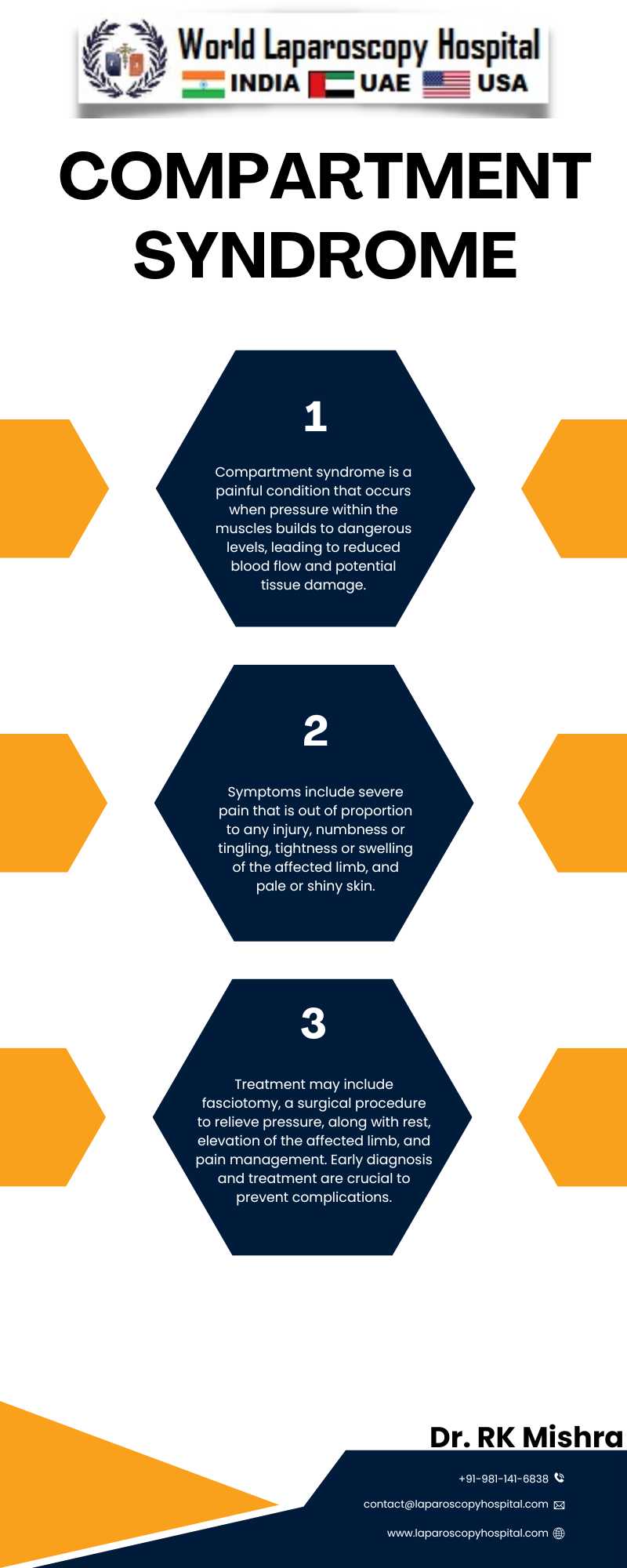Compartment syndrome: Increased pressure within muscle compartments, leading to tissue damage
Compartment Syndrome: Increased Pressure within Muscle Compartments, Leading to Tissue Damage
Compartment syndrome is a serious medical condition characterized by increased pressure within a muscle compartment, leading to reduced blood flow, tissue hypoxia, and potentially irreversible tissue damage. It can occur in any compartment of the body where muscles are contained within a rigid fascial boundary, such as the lower leg, forearm, or hand.

There are two main types of compartment syndrome: acute and chronic. Acute compartment syndrome typically occurs as a result of trauma, such as fractures or crush injuries, which cause bleeding or swelling within the muscle compartment. This sudden increase in pressure can impede blood flow, leading to ischemia and tissue necrosis if not promptly treated. Chronic compartment syndrome, on the other hand, is often related to overuse or repetitive stress injuries, resulting in gradual swelling and increased pressure within the compartment during activity.
The hallmark symptom of compartment syndrome is severe, unrelenting pain that is out of proportion to the injury or activity. Other signs and symptoms may include numbness or tingling, weakness, and swelling or tightness in the affected limb. In severe cases, the lack of blood flow can lead to muscle and nerve damage, as well as the development of compartment syndrome.
Diagnosis of compartment syndrome is based on clinical evaluation, including assessment of symptoms, physical examination, and measurement of compartment pressures using a pressure monitor. Imaging studies, such as MRI or CT scans, may also be used to confirm the diagnosis and assess the extent of tissue damage.
Treatment of compartment syndrome involves relieving the pressure within the affected compartment to restore blood flow and prevent further tissue damage. This may be achieved through surgical intervention, such as fasciotomy, which involves making an incision in the fascia to relieve the pressure. In some cases, conservative measures such as rest, elevation, and pain management may be sufficient, especially in cases of chronic compartment syndrome.
Prevention of compartment syndrome involves proper management of injuries and conditions that can lead to increased compartment pressures, such as fractures, crush injuries, and overuse injuries. It is important to recognize the signs and symptoms of compartment syndrome early and seek prompt medical attention to prevent long-term complications.
Conclusion:
Compartment syndrome is a serious medical condition that can lead to tissue damage and long-term disability if not promptly diagnosed and treated. Understanding the causes, symptoms, and treatment options for compartment syndrome is essential for healthcare providers and individuals at risk of developing this condition.
Compartment syndrome is a serious medical condition characterized by increased pressure within a muscle compartment, leading to reduced blood flow, tissue hypoxia, and potentially irreversible tissue damage. It can occur in any compartment of the body where muscles are contained within a rigid fascial boundary, such as the lower leg, forearm, or hand.

There are two main types of compartment syndrome: acute and chronic. Acute compartment syndrome typically occurs as a result of trauma, such as fractures or crush injuries, which cause bleeding or swelling within the muscle compartment. This sudden increase in pressure can impede blood flow, leading to ischemia and tissue necrosis if not promptly treated. Chronic compartment syndrome, on the other hand, is often related to overuse or repetitive stress injuries, resulting in gradual swelling and increased pressure within the compartment during activity.
The hallmark symptom of compartment syndrome is severe, unrelenting pain that is out of proportion to the injury or activity. Other signs and symptoms may include numbness or tingling, weakness, and swelling or tightness in the affected limb. In severe cases, the lack of blood flow can lead to muscle and nerve damage, as well as the development of compartment syndrome.
Diagnosis of compartment syndrome is based on clinical evaluation, including assessment of symptoms, physical examination, and measurement of compartment pressures using a pressure monitor. Imaging studies, such as MRI or CT scans, may also be used to confirm the diagnosis and assess the extent of tissue damage.
Treatment of compartment syndrome involves relieving the pressure within the affected compartment to restore blood flow and prevent further tissue damage. This may be achieved through surgical intervention, such as fasciotomy, which involves making an incision in the fascia to relieve the pressure. In some cases, conservative measures such as rest, elevation, and pain management may be sufficient, especially in cases of chronic compartment syndrome.
Prevention of compartment syndrome involves proper management of injuries and conditions that can lead to increased compartment pressures, such as fractures, crush injuries, and overuse injuries. It is important to recognize the signs and symptoms of compartment syndrome early and seek prompt medical attention to prevent long-term complications.
Conclusion:
Compartment syndrome is a serious medical condition that can lead to tissue damage and long-term disability if not promptly diagnosed and treated. Understanding the causes, symptoms, and treatment options for compartment syndrome is essential for healthcare providers and individuals at risk of developing this condition.
1 COMMENTS
Dr. Ankit Thakur
#1
Feb 27th, 2024 5:06 pm
Compartment syndrome demands swift recognition and treatment to prevent tissue damage and disability. Healthcare providers and at-risk individuals must comprehend its causes, symptoms, and treatment options for timely intervention and improved outcomes.
| Older Post | Home | Newer Post |





